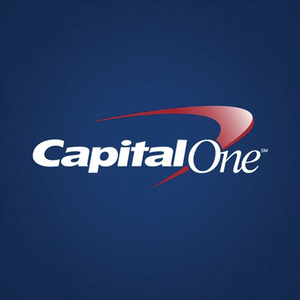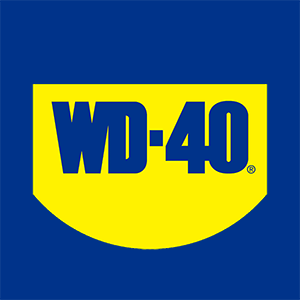
Dole (DOLE)
Dole faces an uphill battle. Its low returns on capital and plummeting sales suggest it struggles to generate demand and profits, a red flag.― StockStory Analyst Team
1. News
2. Summary
Why We Think Dole Will Underperform
Known for its delicious pineapples and Hawaiian roots, Dole (NYSE:DOLE) is a global agricultural company specializing in fresh fruits and vegetables.
- Gross margin of 8.2% is an output of its commoditized products
- Sales stagnated over the last three years and signal the need for new growth strategies
- Operating margin falls short of the industry average, and the smaller profit dollars make it harder to react to unexpected market developments


Dole lacks the business quality we seek. There are superior opportunities elsewhere.
Why There Are Better Opportunities Than Dole
High Quality
Investable
Underperform
Why There Are Better Opportunities Than Dole
Dole’s stock price of $15.25 implies a valuation ratio of 10.8x forward P/E. Yes, this valuation multiple is lower than that of other consumer staples peers, but we’ll remind you that you often get what you pay for.
Our advice is to pay up for elite businesses whose advantages are tailwinds to earnings growth. Don’t get sucked into lower-quality businesses just because they seem like bargains. These mediocre businesses often never achieve a higher multiple as hoped, a phenomenon known as a “value trap”.
3. Dole (DOLE) Research Report: Q3 CY2025 Update
Fresh produce company Dole (NYSE:DOLE) reported Q3 CY2025 results topping the market’s revenue expectations, with sales up 10.5% year on year to $2.28 billion. Its non-GAAP profit of $0.16 per share was in line with analysts’ consensus estimates.
Dole (DOLE) Q3 CY2025 Highlights:
- Revenue: $2.28 billion vs analyst estimates of $2.16 billion (10.5% year-on-year growth, 5.7% beat)
- Adjusted EPS: $0.16 vs analyst estimates of $0.17 (in line)
- Adjusted EBITDA: $80.77 million vs analyst estimates of $77.93 million (3.5% margin, 3.6% beat)
- EBITDA guidance for the full year is $385 million at the midpoint, below analyst estimates of $393.5 million
- Operating Margin: 1.1%, down from 2.4% in the same quarter last year
- Free Cash Flow Margin: 2.9%, similar to the same quarter last year
- Market Capitalization: $1.25 billion
Company Overview
Known for its delicious pineapples and Hawaiian roots, Dole (NYSE:DOLE) is a global agricultural company specializing in fresh fruits and vegetables.
The company was founded in 1901 as the Hawaiian Pineapple Company by James Dole, the “Pineapple King”. Dole’s enterprise was acquired by Castle & Cooke in 1961, who diversified it into other areas of the food industry, and it was once again bought in 1985 by entrepreneur and businessman David Murdock, whose involvement marked a turning point in the company's history.
Murdock recognized Dole’s potential for global growth and aggressively expanded its operations, transforming it into a multi-national corporation. Today, Dole is one of the world's largest producers and distributors of fresh fruits and vegetables, and its portfolio includes not only pineapples but also bananas, strawberries, salads, and more.
To maintain its complex operations, Dole leverages its well-established network of farms, packing facilities, and distribution centers spanning multiple continents, including North America, Latin America, Europe, Asia, and Africa. This extensive supply chain allows Dole to source fresh produce from different regions, ensuring a year-round supply of fruits and vegetables. Few competitors can match Dole's global presence and logistical capabilities.
The company partners with grocery stores, supermarkets, and convenience stores to sell its products. It also supplies restaurants, hotels, and catering companies with fresh produce.
4. Perishable Food
The perishable food industry is diverse, encompassing large-scale producers and distributors to specialty and artisanal brands. These companies sell produce, dairy products, meats, and baked goods and have become integral to serving modern American consumers who prioritize freshness, quality, and nutritional value. Investing in perishable food stocks presents both opportunities and challenges. While the perishable nature of products can introduce risks related to supply chain management and shelf life, it also creates a constant demand driven by the necessity for fresh food. Companies that can efficiently manage inventory, distribution, and quality control are well-positioned to thrive in this competitive market. Navigating the perishable food industry requires adherence to strict food safety standards, regulations, and labeling requirements.
Competitors in the fresh produce category include Calavo Growers (NASDAQ:CVGW), Fresh Del Monte (NYSE:FDP), and Mission Produce (NASDAQ:AVO) along with private companies Chiquita Brands International and Sunkist Growers.
5. Revenue Growth
Reviewing a company’s long-term sales performance reveals insights into its quality. Any business can put up a good quarter or two, but many enduring ones grow for years.
With $8.97 billion in revenue over the past 12 months, Dole is one of the larger consumer staples companies and benefits from a well-known brand that influences purchasing decisions. However, its scale is a double-edged sword because it’s harder to find incremental growth when your existing brands have penetrated most of the market. To accelerate sales, Dole likely needs to optimize its pricing or lean into new products and international expansion.
As you can see below, Dole struggled to increase demand as its $8.97 billion of sales for the trailing 12 months was close to its revenue three years ago. This shows demand was soft, a rough starting point for our analysis.
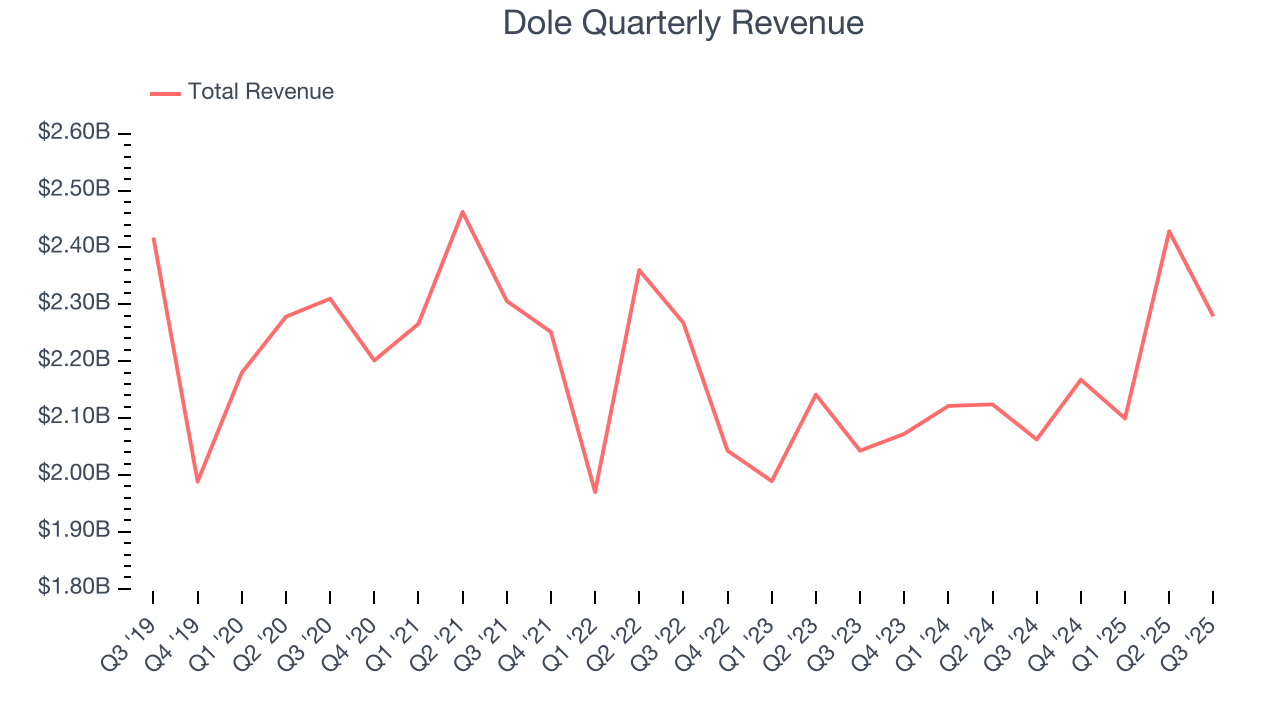
This quarter, Dole reported year-on-year revenue growth of 10.5%, and its $2.28 billion of revenue exceeded Wall Street’s estimates by 5.7%.
Looking ahead, sell-side analysts expect revenue to remain flat over the next 12 months. This projection is underwhelming and indicates its newer products will not lead to better top-line performance yet.
6. Gross Margin & Pricing Power
Dole has bad unit economics for a consumer staples company, signaling it operates in a competitive market and lacks pricing power because its products can be substituted. As you can see below, it averaged a 8.2% gross margin over the last two years. That means Dole paid its suppliers a lot of money ($91.79 for every $100 in revenue) to run its business. 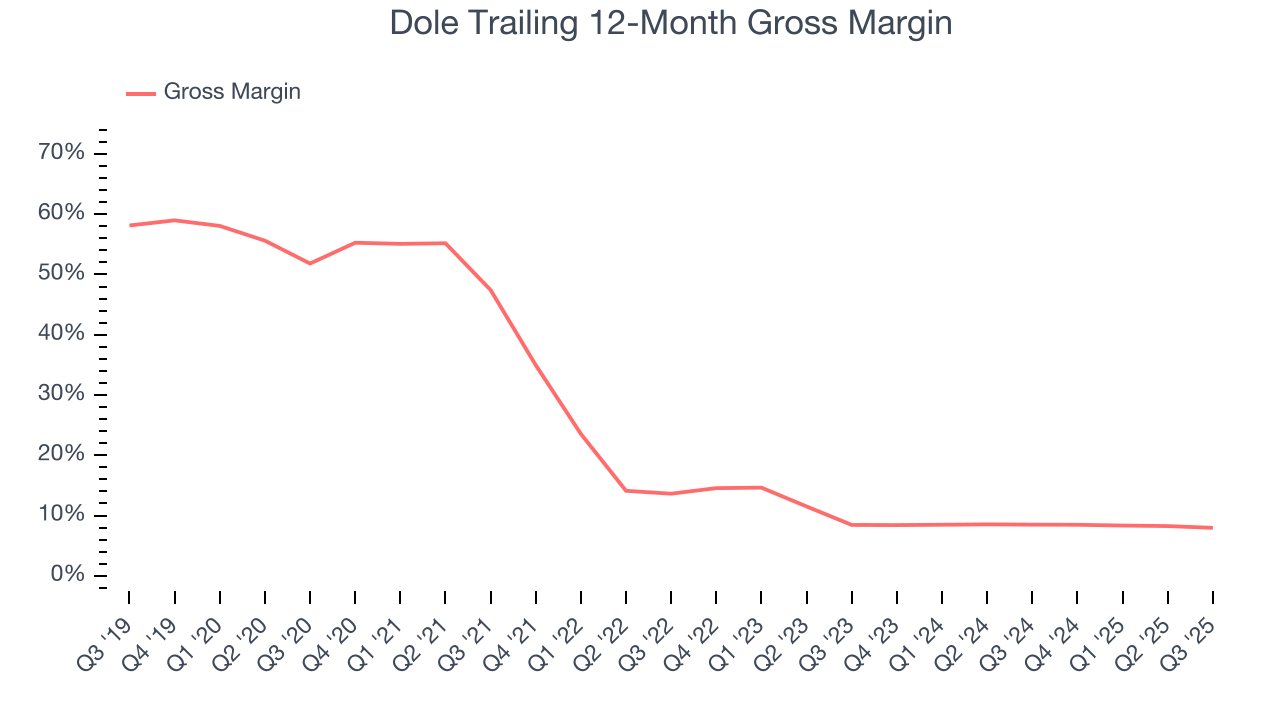
Dole’s gross profit margin came in at 6.8% this quarter, down 1.1 percentage points year on year. Zooming out, the company’s full-year margin has remained steady over the past 12 months, suggesting its input costs (such as raw materials and manufacturing expenses) have been stable and it isn’t under pressure to lower prices.
7. Operating Margin
Dole’s operating margin might fluctuated slightly over the last 12 months but has generally stayed the same, averaging 2.6% over the last two years. This profitability was paltry for a consumer staples business and caused by its suboptimal cost structureand low gross margin.
Analyzing the trend in its profitability, Dole’s operating margin might fluctuated slightly but has generally stayed the same over the last year, meaning it will take a fundamental shift in the business model to change.
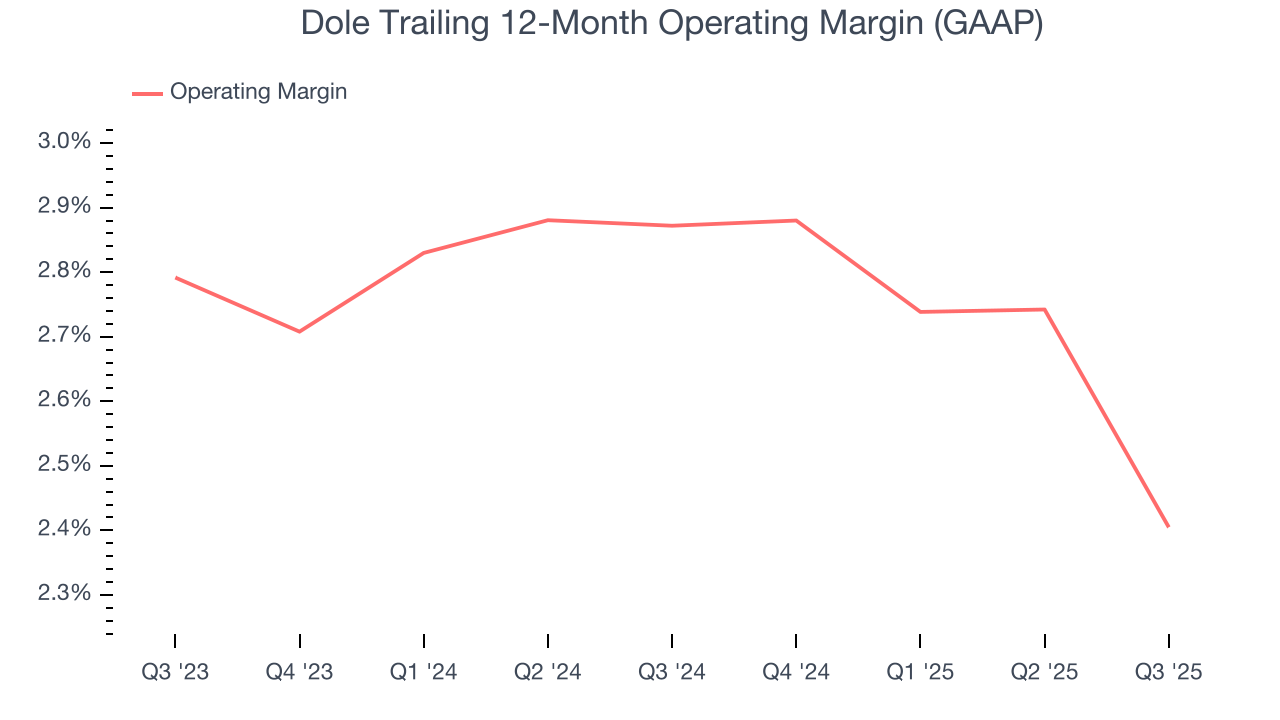
This quarter, Dole generated an operating margin profit margin of 1.1%, down 1.3 percentage points year on year. Since Dole’s operating margin decreased more than its gross margin, we can assume it was less efficient because expenses such as marketing, and administrative overhead increased.
8. Earnings Per Share
We track the change in earnings per share (EPS) for the same reason as long-term revenue growth. Compared to revenue, however, EPS highlights whether a company’s growth is profitable.
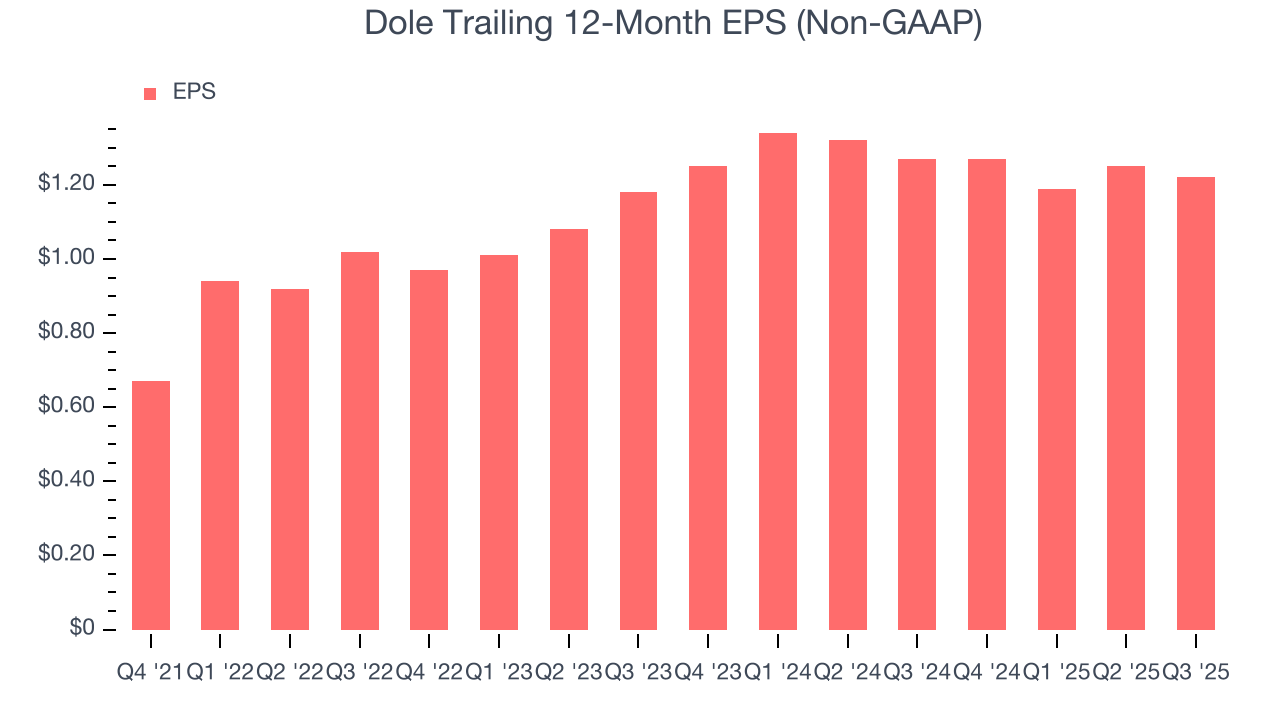
In Q3, Dole reported adjusted EPS of $0.16, down from $0.19 in the same quarter last year. This print missed analysts’ estimates, but we care more about long-term adjusted EPS growth than short-term movements. Over the next 12 months, Wall Street expects Dole’s full-year EPS of $1.22 to grow 15.6%.
9. Cash Is King
If you’ve followed StockStory for a while, you know we emphasize free cash flow. Why, you ask? We believe that in the end, cash is king, and you can’t use accounting profits to pay the bills.
Dole has shown weak cash profitability over the last two years, giving the company limited opportunities to return capital to shareholders. Its free cash flow margin averaged 1.3%, subpar for a consumer staples business.
Taking a step back, we can see that Dole’s margin dropped by 1.2 percentage points over the last year. Almost any movement in the wrong direction is undesirable because of its already low cash conversion. If the trend continues, it could signal it’s in the middle of an investment cycle.
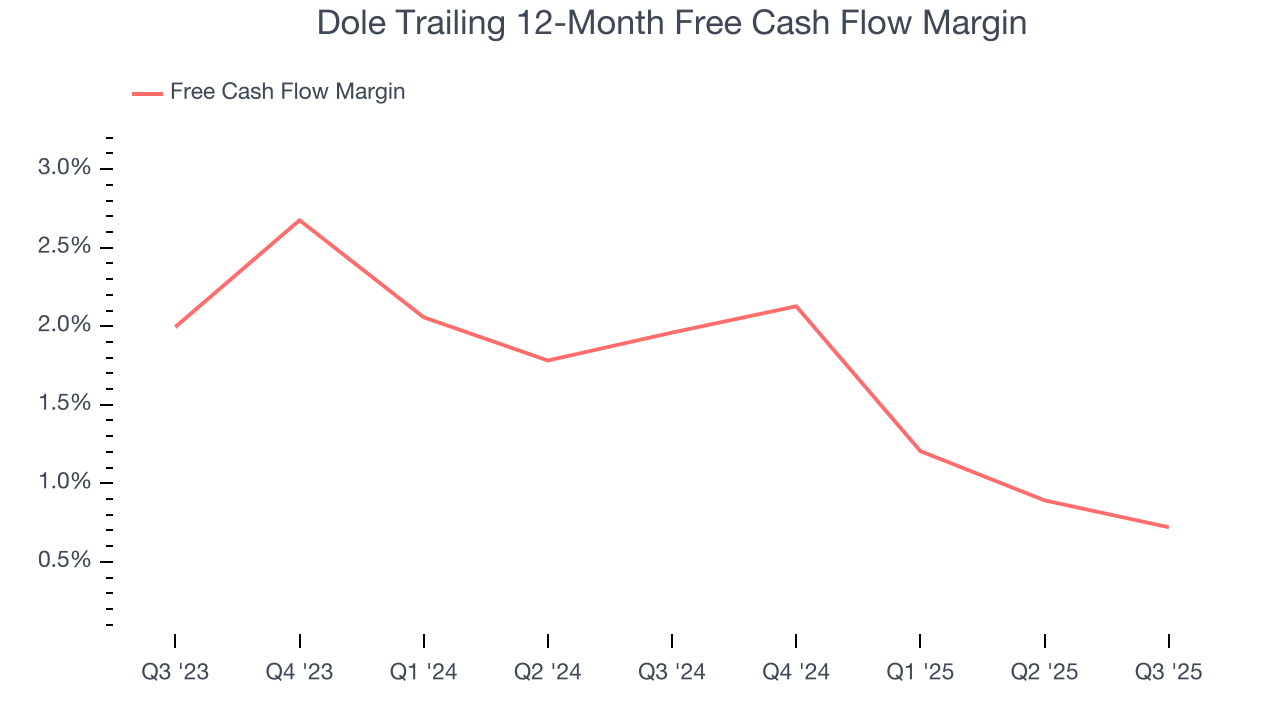
Dole’s free cash flow clocked in at $66.48 million in Q3, equivalent to a 2.9% margin. This cash profitability was in line with the comparable period last year and above its two-year average.
10. Return on Invested Capital (ROIC)
EPS and free cash flow tell us whether a company was profitable while growing its revenue. But was it capital-efficient? A company’s ROIC explains this by showing how much operating profit it makes compared to the money it has raised (debt and equity).
Dole historically did a mediocre job investing in profitable growth initiatives. Its five-year average ROIC was 7.3%, somewhat low compared to the best consumer staples companies that consistently pump out 20%+.
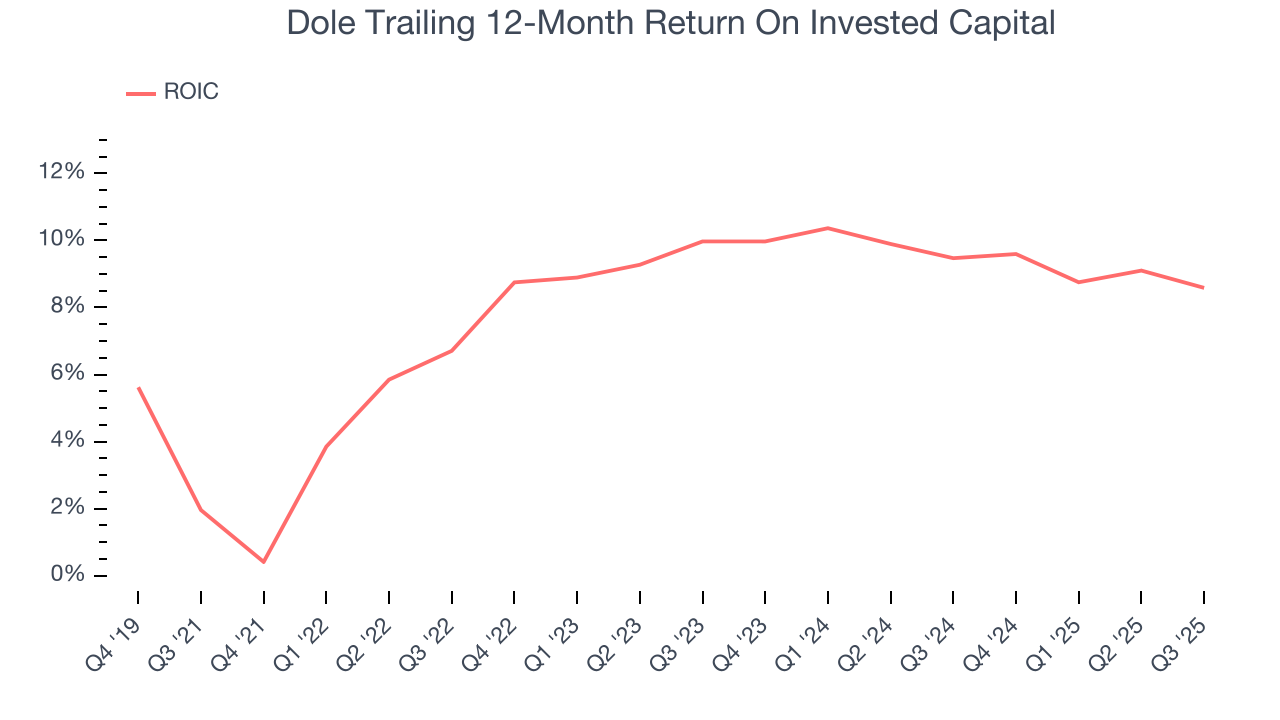
11. Balance Sheet Assessment
Dole reported $321 million of cash and $956.7 million of debt on its balance sheet in the most recent quarter. As investors in high-quality companies, we primarily focus on two things: 1) that a company’s debt level isn’t too high and 2) that its interest payments are not excessively burdening the business.
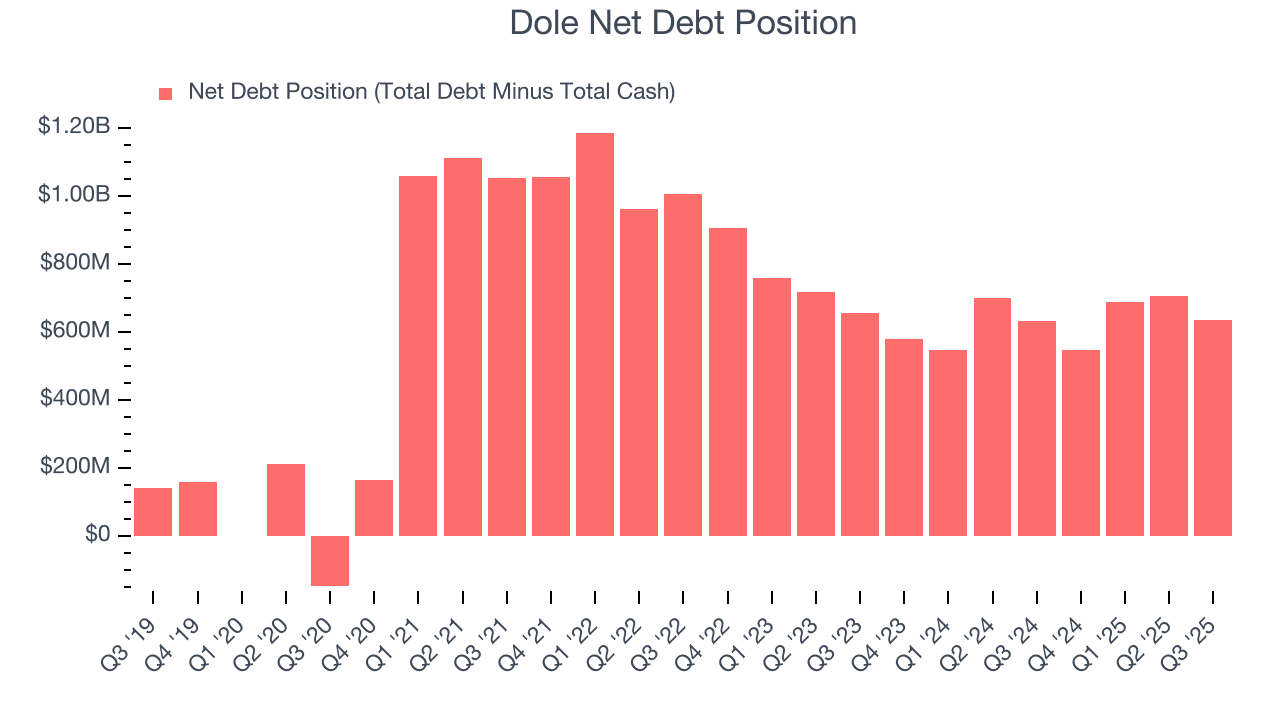
With $360.1 million of EBITDA over the last 12 months, we view Dole’s 1.8× net-debt-to-EBITDA ratio as safe. We also see its $31.19 million of annual interest expenses as appropriate. The company’s profits give it plenty of breathing room, allowing it to continue investing in growth initiatives.
12. Key Takeaways from Dole’s Q3 Results
We enjoyed seeing Dole beat analysts’ revenue expectations this quarter. We were also happy its EBITDA outperformed Wall Street’s estimates. On the other hand, its EBITDA guidance fell short of Wall Street’s estimates. Zooming out, we think this was a mixed quarter. The stock traded up 3.2% to $13.55 immediately after reporting.
13. Is Now The Time To Buy Dole?
Updated: December 24, 2025 at 9:46 PM EST
We think that the latest earnings result is only one piece of the bigger puzzle. If you’re deciding whether to own Dole, you should also grasp the company’s longer-term business quality and valuation.
We see the value of companies helping consumers, but in the case of Dole, we’re out. For starters, its revenue growth was weak over the last three years. And while its favorable brand awareness gives it meaningful influence over consumers’ dining decisions, the downside is its gross margins make it more challenging to reach positive operating profits compared to other consumer staples businesses. On top of that, its operating margins are low compared to other consumer staples companies.
Dole’s P/E ratio based on the next 12 months is 10.8x. This valuation multiple is fair, but we don’t have much confidence in the company. There are better stocks to buy right now.
Wall Street analysts have a consensus one-year price target of $17.50 on the company (compared to the current share price of $15.25).

